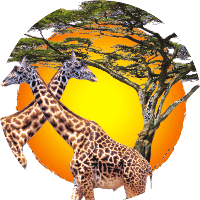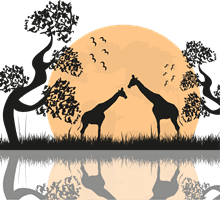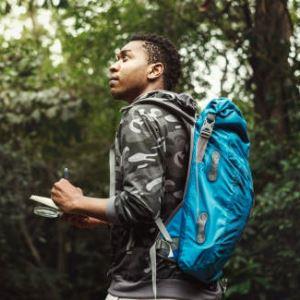 Giraffe sanctuary volunteer programs in Kenya offer Germans an unforgettable blend of wildlife conservation and African adventure. For travelers from Germany who are passionate about nature and seeking hands-on experiences, these opportunities provide a meaningful way to connect with both animals and the local culture. The giraffe, one of Africa’s most iconic creatures, becomes more than just a photo opportunity; it becomes the heart of a purposeful journey. Volunteering at a giraffe sanctuary involves much more than just observation. Germans can contribute to crucial conservation efforts, including habitat protection, giraffe behavior monitoring, and assisting with educational outreach programs. Locations such as the renowned Giraffe Centre in Nairobi and community-driven sanctuaries across Kenya welcome international volunteers eager to make a difference. These programs are structured yet flexible, often accommodating individuals, students, retirees, and even families. For Germans looking to pair their volunteer service with exploration, Kenya’s safari tours provide the perfect complement. Picture early morning game drives through the Maasai Mara, sunset views in Amboseli, and close encounters with giraffes roaming freely through acacia-dotted plains. Many tour operators cater specifically to German travelers, offering itineraries in the German language and providing a mix of wildlife, comfort, and cultural immersion. Whether staying in eco-lodges or camping under the stars, these safaris showcase the untamed beauty of Kenya. Combining volunteering and safari tours creates a more immersive and holistic travel experience. Germans can begin their journey by contributing directly to conservation projects, followed by a rewarding exploration of Kenya’s diverse landscapes and ecosystems. Some programs even offer hybrid packages that include both volunteering stints and safari excursions, taking the guesswork out of planning and ensuring travelers get the best of both worlds. In addition to volunteering and safaris, Germans can also participate in giraffe adoption programs. These initiatives allow individuals to sponsor a giraffe, receive regular updates, and support sanctuary operations from afar or during a personal visit. Educational tours for German school groups and university students are also available, adding an academic layer to the adventure. Before embarking on this journey, Germans should be aware of a few travel essentials. Kenya requires a valid eVisa for entry, and vaccinations such as yellow fever are recommended. Travel insurance is advisable, and packing should include essentials for both rural volunteering and safari conditions. Planning ahead ensures a smoother, safer, and more fulfilling experience. Giraffe-focused travel in Kenya offers Germans a unique chance to give back, learn, and marvel at one of nature’s most graceful animals. The experience of seeing giraffes up close in their natural environment, combined with meaningful contributions to their conservation, creates memories that last a lifetime. Whether Germans are participating in hands-on sanctuary work, enjoying thrilling safari drives through Kenya’s vast landscapes, or engaging in educational initiatives that foster deeper understanding, this type of travel is both enriching and rewarding. Beyond the personal fulfillment it provides, giraffe-centered tourism directly supports the local economy and environmental efforts, ensuring that future generations can enjoy Kenya’s rich biodiversity. This is a journey that not only transforms the traveler’s perspective but also leaves a lasting, positive impact on the lives of the giraffes and the communities dedicated to protecting them.
Giraffe sanctuary volunteer programs in Kenya offer Germans an unforgettable blend of wildlife conservation and African adventure. For travelers from Germany who are passionate about nature and seeking hands-on experiences, these opportunities provide a meaningful way to connect with both animals and the local culture. The giraffe, one of Africa’s most iconic creatures, becomes more than just a photo opportunity; it becomes the heart of a purposeful journey. Volunteering at a giraffe sanctuary involves much more than just observation. Germans can contribute to crucial conservation efforts, including habitat protection, giraffe behavior monitoring, and assisting with educational outreach programs. Locations such as the renowned Giraffe Centre in Nairobi and community-driven sanctuaries across Kenya welcome international volunteers eager to make a difference. These programs are structured yet flexible, often accommodating individuals, students, retirees, and even families. For Germans looking to pair their volunteer service with exploration, Kenya’s safari tours provide the perfect complement. Picture early morning game drives through the Maasai Mara, sunset views in Amboseli, and close encounters with giraffes roaming freely through acacia-dotted plains. Many tour operators cater specifically to German travelers, offering itineraries in the German language and providing a mix of wildlife, comfort, and cultural immersion. Whether staying in eco-lodges or camping under the stars, these safaris showcase the untamed beauty of Kenya. Combining volunteering and safari tours creates a more immersive and holistic travel experience. Germans can begin their journey by contributing directly to conservation projects, followed by a rewarding exploration of Kenya’s diverse landscapes and ecosystems. Some programs even offer hybrid packages that include both volunteering stints and safari excursions, taking the guesswork out of planning and ensuring travelers get the best of both worlds. In addition to volunteering and safaris, Germans can also participate in giraffe adoption programs. These initiatives allow individuals to sponsor a giraffe, receive regular updates, and support sanctuary operations from afar or during a personal visit. Educational tours for German school groups and university students are also available, adding an academic layer to the adventure. Before embarking on this journey, Germans should be aware of a few travel essentials. Kenya requires a valid eVisa for entry, and vaccinations such as yellow fever are recommended. Travel insurance is advisable, and packing should include essentials for both rural volunteering and safari conditions. Planning ahead ensures a smoother, safer, and more fulfilling experience. Giraffe-focused travel in Kenya offers Germans a unique chance to give back, learn, and marvel at one of nature’s most graceful animals. The experience of seeing giraffes up close in their natural environment, combined with meaningful contributions to their conservation, creates memories that last a lifetime. Whether Germans are participating in hands-on sanctuary work, enjoying thrilling safari drives through Kenya’s vast landscapes, or engaging in educational initiatives that foster deeper understanding, this type of travel is both enriching and rewarding. Beyond the personal fulfillment it provides, giraffe-centered tourism directly supports the local economy and environmental efforts, ensuring that future generations can enjoy Kenya’s rich biodiversity. This is a journey that not only transforms the traveler’s perspective but also leaves a lasting, positive impact on the lives of the giraffes and the communities dedicated to protecting them.
Quick Reference Guide for Germans Visiting Giraffe Sites in Kenya
| Feature | Details |
|---|---|
| Best Time to Visit | June to October (Dry Season) |
| Top Locations | Giraffe Centre, Maasai Mara, Nairobi NP |
| Volunteer Duration | 1 to 12 weeks |
| Tour Language | English and German-speaking guides |
| Average Cost | €500–€3000 depending on package |
| Activities | Feeding, monitoring, game drives, cultural tours |
| Visa Required for Germans | Yes, eVisa before arrival |
| Health Requirements | Yellow fever vaccine, travel insurance |
| Who Can Join | Individuals, families, students, retirees |
| Combo Options | Volunteer + Safari, Education + Adoption |
Giraffe Sanctuary Volunteering Experiences for Germans in Kenya
Germans seeking a unique and impactful travel experience will find that volunteering at giraffe sanctuaries in Kenya offers the perfect balance of adventure, conservation, and cultural exchange. These programs are designed not only to protect one of Africa’s most beloved animals but also to provide immersive learning and hands-on engagement for international volunteers. Kenya giraffe orphanage volunteer opportunities attract people of all ages and backgrounds, including students, retirees, and families from Germany. Volunteers are typically involved in a wide range of activities such as feeding, health monitoring, enrichment exercises, and habitat maintenance. These programs also include educational sessions that help volunteers understand giraffe biology, conservation challenges, and the importance of preserving their natural habitat. Well-established locations like the Giraffe Centre in Nairobi and various private conservancies across the country offer structured programs that include accommodation, meals, and orientation. These placements range from short-term options of one week to longer-term commitments of several months. German participants often appreciate the flexibility and the opportunity to directly impact giraffe conservation while enjoying Kenya's breathtaking landscapes. The volunteering experience is further enriched by interactions with local communities. Many programs incorporate cultural exchange elements such as Swahili lessons, visits to local schools, or involvement in community development projects. These interactions allow Germans to gain a deeper appreciation of Kenyan life and to contribute to broader social goals beyond wildlife conservation. Preparing for a volunteer journey involves some practical considerations. Germans should ensure they obtain the necessary eVisa before travel, as well as vaccinations such as yellow fever. It is also advisable to secure comprehensive travel insurance and prepare for varying climates, particularly if the program is based in rural or semi-arid regions. German volunteers frequently combine their conservation work with travel, making the most of Kenya’s world-famous safari opportunities. Many programs offer optional weekend trips to destinations like Maasai Mara, Amboseli National Park, and Lake Nakuru. These excursions allow volunteers to witness giraffes, elephants, lions, and other wildlife in their natural habitats, creating a well-rounded and unforgettable experience. What sets giraffe sanctuary volunteering apart is the personal connection formed with these gentle giants. Feeding giraffes by hand, observing their unique behaviors, and playing a role in their care creates lasting emotional bonds. Germans who participate often report feeling deeply moved and inspired by their time in Kenya, returning home with a renewed sense of environmental stewardship. Whether for academic enrichment, a career break, or a soul-searching adventure, these volunteering opportunities provide more than just a travel story they cultivate purpose. Germans who embark on this journey become part of a global effort to protect giraffes for future generations. It’s a meaningful experience that blends adventure, learning, and compassion in one of the most stunning corners of the world.
How Can Germans Volunteer at Giraffe Sanctuaries in Kenya?
Volunteering at giraffe sanctuaries in Kenya gives Germans a unique opportunity to support wildlife conservation while engaging in cultural exchange. Kenya is known for its rich biodiversity, and giraffes remain one of the most cherished species to protect. These sanctuaries are not only focused on rescuing and rehabilitating giraffes, but also serve as educational hubs and conservation centers that welcome international support.
- Choose the Right Sanctuary Program: Germans interested in giraffe volunteering should begin by researching reputable programs. Look for those based in Nairobi, Naivasha, or Laikipia, which offer structured schedules, safe accommodations, and detailed orientation. These sanctuaries focus on daily care, education, and conservation awareness, giving Germans hands-on roles. Many programs cater to first-time volunteers, and even offer cultural activities alongside conservation tasks to make the stay more enriching.
- Understand Your Daily Responsibilities: Volunteers typically assist with feeding, cleaning enclosures, monitoring giraffe behavior, and supporting veterinary checks. Educational outreach is also common, helping spread conservation messages to local communities and visiting students. Tasks are often rotated and conducted in teams, creating a collaborative atmosphere. Participants from Germany should expect both physically active and reflective duties that align with the sanctuary’s goals.
- Connect Through Cultural Immersion: Beyond animal care, programs often include cultural components like Swahili language lessons, cooking traditional Kenyan dishes, or participating in local ceremonies. This helps Germans immerse themselves in Kenyan life while developing a global perspective. Volunteering becomes not only a journey to help animals, but also an experience of personal growth and intercultural friendship.
- Combine with Safari Adventures: After volunteering, many Germans extend their stay by joining safari tours across Kenya. Visits to the Maasai Mara, Tsavo, and Amboseli allow them to witness giraffes and other wildlife in their natural habitat. Some programs even include these excursions, blending conservation and tourism. It’s an ideal way to reflect on one’s contribution while enjoying Kenya’s natural beauty.
- Prepare for Travel and Safety Essentials: Before flying to Kenya, Germans should apply for an eVisa, get vaccinations like yellow fever, and secure travel insurance. It’s essential to pack clothing suitable for both warm days and cool evenings. Programs often send packing lists ahead of time. While Kenya is generally safe for tourists, following local guidance ensures a smooth and enriching experience.
- Make a Lasting Impact: Animal conservation volunteering in Kenya for Germans provides more than a meaningful vacation it inspires stewardship and creates lifelong memories. By participating in giraffe care and connecting with local communities, Germans play a vital role in global conservation. Many leave not just with photos, but with deeper knowledge, empathy, and the desire to return or support similar efforts elsewhere.
Giraffe sanctuary volunteering in Kenya opens doors to service, education, and adventure. It offers Germans a rare opportunity to make a tangible impact while discovering the beauty and complexity of Africa’s wildlife and culture. The experience allows participants to step into a different rhythm of life, where giraffes are not just majestic animals but symbols of ongoing conservation work. Germans who engage in these programs often return home transformed, inspired to advocate for wildlife protection both locally and globally, creating ripples of change far beyond Kenya.
Safari Tours Featuring Giraffes and Kenyan Wildlife for Germans
Kenya is one of Africa's most breathtaking safari destinations, offering Germans an exceptional chance to see giraffes and other wildlife in their natural environment. From the golden savannas of Maasai Mara to the lush wetlands of Lake Nakuru, safari experiences in Kenya are unforgettable. With customized packages and options for German-speaking guides, travelers from Germany can explore this diverse landscape with ease and cultural connection. The country's giraffe populations, including the endangered Rothschild’s giraffe, thrive in protected parks, conservancies, and open plains making sightings not only likely but often magical. Safari tours and giraffe sanctuary visit in Kenya combine education, conservation, and excitement. Visitors might start their day observing a tower of giraffes in the wild and end it by hand-feeding rescued giraffes at a sanctuary. Nairobi National Park is a favorite for short trips, offering wildlife encounters just minutes from the city. More immersive options include guided drives through Amboseli, known for giraffes framed by Mount Kilimanjaro, and Samburu, a haven for rare northern species. Many tours include cultural experiences as well interactions with Maasai communities, traditional meals, and visits to local markets add depth to the wildlife adventure. These elements allow Germans to not only enjoy Kenya’s rich biodiversity but also to understand the people who share the land with the animals. Such experiences create stronger connections and lasting memories. Tour providers cater to a wide range of preferences and budgets. Some offer family-friendly packages, while others target couples seeking luxury or solo travelers looking for group adventures. Accommodations vary from eco-lodges to luxury tented camps, often with views of watering holes frequented by giraffes and other animals. Many German tourists appreciate the added comfort of having native-language support and curated itineraries. The best time for a safari is during the dry season, typically from June to October. During this period, wildlife congregates around water sources, making sightings easier. Tourists are encouraged to pack light but practical clothing, sun protection, binoculars, and quality cameras. Safety is generally not a concern in the parks, especially when guided by certified operators. For Germans combining a love for giraffes with a sense of adventure, Kenya’s safaris are more than just sightseeing they're transformative journeys through landscapes where nature thrives and conservation comes alive. These tours offer immersive opportunities to observe giraffes in the wild, learning about their behavior, habitats, and role in Kenya’s ecosystems. The unique combination of wildlife observation and cultural interaction enriches the experience, turning every game drive into an educational encounter. These safaris also provide a chance to disconnect from fast-paced daily routines and reconnect with nature’s rhythm. Whether joining a sunrise drive through the Maasai Mara or gazing at giraffes grazing beneath acacia trees, the moments are both peaceful and awe-inspiring. Travelers often feel a renewed sense of respect for wildlife and a stronger commitment to sustainability. Whether it’s a first-time visit or a returning adventure, the memories made during these giraffe-focused safaris are sure to last a lifetime.
What Safari Tours Are Best for Germans to See Giraffes in Kenya?
Kenya is home to some of the most iconic safari experiences on the African continent, and for German travelers, it presents a perfect blend of adventure and wildlife appreciation. Among its many natural treasures, the giraffe stands tall both literally and symbolically; as a representative of Kenya’s rich biodiversity. For Germans seeking up-close encounters with these graceful animals, safari tours centered around giraffe conservation and observation provide a highly rewarding journey. The Giraffe Centre in Nairobi serves as a unique gateway into the world of giraffe preservation. German-friendly safari tours in the Giraffe Centre in Kenya are tailored to cater to German-speaking tourists, offering interpreters, translated materials, and comfortable accommodations. These tours often begin with guided sessions at the Giraffe Centre where visitors learn about the Rothschild’s giraffe and its conservation efforts, followed by extended game drives in nearby reserves and national parks. Destinations such as Nairobi National Park, Maasai Mara, and Lake Nakuru are easily accessible and rich in giraffe populations. Many tour packages combine traditional safari experiences; like observing herds of giraffes from open-roof vehicles with interactive activities such as feeding and photographing rescued giraffes. Some even include overnight stays in eco-lodges where giraffes wander close to the visitor’s balcony. The advantage of these curated tours lies in their attention to both language and cultural nuances. German visitors appreciate itineraries that account for their dietary preferences, pace of travel, and desire for deeper cultural context. Tour guides often include stops at Maasai villages, local artisan workshops, and scenic viewpoints that enhance the overall experience. Seasonal considerations are also important. The dry months from June to October offer the best wildlife visibility, and many operators offer discounts for early bookings or group travel. Whether you’re traveling solo, with family, or as part of an educational group, there are packages that suit every budget and interest. For Germans wishing to combine wildlife education with natural beauty and cultural exchange, giraffe-focused safari tours are the ideal option. They offer the chance to observe giraffes not just in protected enclosures but also in their expansive native habitats. The experience is not only entertaining but also enlightening; promoting a deeper understanding of Kenya’s efforts in wildlife conservation and the role international tourists can play in supporting those efforts.
Giraffe Adoption, Educational Tours, and Volunteer-Safari Combos
 Germans looking for a deeper connection to giraffe conservation in Kenya can find numerous opportunities that combine learning, service, and travel. From educational group visits to long-term adoption support, each option enriches the traveler’s understanding of wildlife and ecological balance. These programs are tailored to foster awareness and participation in preserving Kenya’s giraffe populations while also offering unforgettable cultural experiences. One of the most meaningful ways to support giraffe conservation is through giraffe adoption programs. The Giraffe Centre in Nairobi offers an option for Germans to symbolically adopt a giraffe, supporting medical care, habitat maintenance, and education campaigns. Adopters receive regular updates, photos, and even invitations for in-person visits. These initiatives are ideal for families, school groups, or individuals wanting to stay connected to conservation efforts from afar. Educational tours are another powerful option for German travelers, especially students and academic groups. These programs include lectures on biodiversity, field excursions, and interactive sessions with conservationists. Often led by bilingual guides, these experiences balance wildlife knowledge with cultural exchange, creating well-rounded educational value. Schools and universities in Germany increasingly partner with Kenyan organizations to incorporate such programs into their curricula. Volunteer-safari combinations remain among the most popular offerings. These hybrid programs allow Germans to begin their journey by assisting in sanctuary activities such as feeding giraffes, collecting data, or supporting community outreach. After this hands-on involvement, participants transition to multi-day wildlife excursions. Guided giraffe safari tours in Kenya for Germans take volunteers to national parks like Maasai Mara, Amboseli, or Samburu, where giraffes roam freely in their natural habitats. These packages are designed with German travelers in mind, often including translation services, culturally sensitive accommodations, and flexible itineraries. The beauty of these integrated experiences lies in their holistic nature. They engage both the heart and mind, allowing participants to bond with giraffes while actively contributing to their conservation and habitat protection. These programs are more than just tourism; they are immersive journeys that foster awareness, empathy, and real-world understanding of endangered species. Participants also gain valuable cultural insights through Kenya’s rich traditions. From sharing meals with local families to learning tribal dances and crafts, Germans are welcomed into communities that live harmoniously with wildlife. These moments help volunteers appreciate the connection between conservation and culture. These experiences inspire long-term commitment. Many Germans return home eager to support conservation causes, share their journey with others, or plan future trips. The combination of hands-on wildlife care, education, and cultural exchange not only enriches the traveler but strengthens the global movement to protect Africa’s giraffes. These experiences serve as more than temporary getaways they create ambassadors for wildlife, sparking conversations and raising awareness about giraffe conservation across Europe. Volunteers often speak of life-changing moments, such as witnessing a rescued giraffe's progress or participating in a community event where conservation is celebrated. These emotional connections linger long after the trip ends. Germans frequently find themselves inspired to engage in environmental education, participate in fundraising efforts, or even return to Kenya with friends and family. The memories formed whether it’s watching a giraffe at sunset, sharing laughter with local children, or collaborating with Kenyan conservationists leave a deep, lasting imprint on the heart and encourage lifelong dedication to preserving wildlife and ecosystems around the world.
Germans looking for a deeper connection to giraffe conservation in Kenya can find numerous opportunities that combine learning, service, and travel. From educational group visits to long-term adoption support, each option enriches the traveler’s understanding of wildlife and ecological balance. These programs are tailored to foster awareness and participation in preserving Kenya’s giraffe populations while also offering unforgettable cultural experiences. One of the most meaningful ways to support giraffe conservation is through giraffe adoption programs. The Giraffe Centre in Nairobi offers an option for Germans to symbolically adopt a giraffe, supporting medical care, habitat maintenance, and education campaigns. Adopters receive regular updates, photos, and even invitations for in-person visits. These initiatives are ideal for families, school groups, or individuals wanting to stay connected to conservation efforts from afar. Educational tours are another powerful option for German travelers, especially students and academic groups. These programs include lectures on biodiversity, field excursions, and interactive sessions with conservationists. Often led by bilingual guides, these experiences balance wildlife knowledge with cultural exchange, creating well-rounded educational value. Schools and universities in Germany increasingly partner with Kenyan organizations to incorporate such programs into their curricula. Volunteer-safari combinations remain among the most popular offerings. These hybrid programs allow Germans to begin their journey by assisting in sanctuary activities such as feeding giraffes, collecting data, or supporting community outreach. After this hands-on involvement, participants transition to multi-day wildlife excursions. Guided giraffe safari tours in Kenya for Germans take volunteers to national parks like Maasai Mara, Amboseli, or Samburu, where giraffes roam freely in their natural habitats. These packages are designed with German travelers in mind, often including translation services, culturally sensitive accommodations, and flexible itineraries. The beauty of these integrated experiences lies in their holistic nature. They engage both the heart and mind, allowing participants to bond with giraffes while actively contributing to their conservation and habitat protection. These programs are more than just tourism; they are immersive journeys that foster awareness, empathy, and real-world understanding of endangered species. Participants also gain valuable cultural insights through Kenya’s rich traditions. From sharing meals with local families to learning tribal dances and crafts, Germans are welcomed into communities that live harmoniously with wildlife. These moments help volunteers appreciate the connection between conservation and culture. These experiences inspire long-term commitment. Many Germans return home eager to support conservation causes, share their journey with others, or plan future trips. The combination of hands-on wildlife care, education, and cultural exchange not only enriches the traveler but strengthens the global movement to protect Africa’s giraffes. These experiences serve as more than temporary getaways they create ambassadors for wildlife, sparking conversations and raising awareness about giraffe conservation across Europe. Volunteers often speak of life-changing moments, such as witnessing a rescued giraffe's progress or participating in a community event where conservation is celebrated. These emotional connections linger long after the trip ends. Germans frequently find themselves inspired to engage in environmental education, participate in fundraising efforts, or even return to Kenya with friends and family. The memories formed whether it’s watching a giraffe at sunset, sharing laughter with local children, or collaborating with Kenyan conservationists leave a deep, lasting imprint on the heart and encourage lifelong dedication to preserving wildlife and ecosystems around the world.
Can Germans Combine Giraffe Volunteering with Safari Adventures?
Many German travelers are increasingly seeking meaningful ways to combine their passion for wildlife with the thrill of exploring new destinations. In Kenya, this is not only possible it’s encouraged through well-structured giraffe volunteering and safari combo programs. These experiences offer an enriching balance between contributing to conservation and enjoying the country’s stunning biodiversity. Volunteering typically begins at sanctuaries like the Giraffe Centre in Nairobi or other private conservancies. Germans assist with giraffe feeding, habitat management, behavioral observation, and educational outreach. These programs are hands-on and highly immersive, allowing volunteers to develop a close connection with the animals while contributing to their wellbeing. Volunteers often work alongside experienced conservationists, gaining insights into Kenya’s ecological efforts and challenges. Once the volunteering segment is complete, participants transition into the safari phase. This leg of the journey offers a change of pace trading work boots for binoculars as they explore Kenya’s famous reserves like Maasai Mara, Samburu, or Tsavo. Game drives provide spectacular opportunities to see giraffes in their natural habitat, alongside elephants, lions, and countless other species. Some tours also integrate cultural experiences such as Maasai village visits or traditional craft workshops, adding depth to the adventure. For Germans, these hybrid experiences are particularly appealing because they are often tailored to accommodate language preferences, dietary needs, and comfort levels. Whether traveling solo, with family, or in a group, these programs are adaptable, ensuring a fulfilling experience for everyone involved. Combining giraffe volunteering with safari adventures allows Germans to leave a positive footprint while also indulging in Kenya’s scenic beauty and wildlife. This dual experience deepens the emotional and educational impact of the trip, enabling travelers to form strong connections with the animals and the local communities they support. Through volunteering, Germans directly contribute to habitat preservation and the well-being of giraffes, while safaris offer an awe-inspiring glimpse into the wild. These journeys are not just about observing nature they’re about becoming part of it. By engaging in both structured conservation efforts and leisurely exploration, travelers enjoy a balanced adventure that is both meaningful and memorable. The combination of purposeful work and leisure makes for a well-rounded, unforgettable journey that fosters personal growth, strengthens environmental awareness, and builds lifelong memories centered around the beauty and wonder of giraffes in their natural habitat.
FAQs About Giraffe Conservation Tours for Germans in Kenya
Giraffe conservation tours in Kenya are an ideal opportunity for Germans to combine wildlife education, adventure, and cultural experiences. Whether you're considering volunteering at a giraffe sanctuary or planning a full safari tour, there are essential details to know before booking your journey. This guide answers common questions with concise explanations designed to help German travelers plan a smooth and meaningful trip to Kenya's giraffe centers and safari destinations.
- What Is the Best Time for Germans to Visit Giraffe Sites in Kenya? The dry season from June to October is the best time for Germans to visit Kenya. During this period, wildlife gathers near water sources, making giraffe sightings more frequent. The climate is also cooler and more pleasant for game drives and outdoor volunteering. This timing aligns well with European summer holidays, making it convenient for German travelers seeking extended stays.
- Do Giraffe Tours in Kenya Offer German-Speaking Guides? Yes, many tour operators offer German-speaking guides or interpreters. This ensures clear communication during game drives, cultural visits, and sanctuary orientations. Some providers also offer printed materials in German, making the experience more accessible. This is particularly useful for older travelers or school groups from Germany who prefer native language support while learning about giraffe conservation.
- Can Families from Germany Participate in Giraffe Conservation Programs? Absolutely. Many giraffe sanctuaries in Kenya welcome German families with children. These programs offer age-appropriate activities such as feeding giraffes, educational talks, and wildlife tracking. Family-friendly accommodations are also available. It's a unique way for parents and children to bond while learning about conservation and exploring Kenya’s incredible biodiversity together.
- What Vaccinations Do Germans Need Before Traveling to Kenya? Germans planning to visit Kenya should get the yellow fever vaccine, which is required for entry. It’s also advisable to consider vaccinations for hepatitis A, typhoid, and tetanus. Travel insurance with medical coverage is essential. Consulting a travel clinic 6-8 weeks before departure ensures you meet health requirements and get personalized advice.
- Are There Giraffe Volunteer Options for German Students and Retirees? Yes, both students and retirees from Germany can join giraffe volunteer programs. Students often participate during gap years or academic breaks, gaining conservation experience. Retirees bring life experience and often mentor younger volunteers. These programs are flexible, offering both short and long-term placements that suit different ages and mobility levels.
- What Is Included in a Typical Giraffe Conservation Tour Package? Tour packages usually include airport transfers, accommodations, meals, guided activities, and conservation work. Some packages bundle safari tours, cultural visits, and language assistance. Germans can choose from eco-lodges, tented camps, or guesthouses. Transportation to national parks and sanctuaries is also arranged, ensuring a stress-free and enjoyable experience.
- How Can Germans Adopt a Giraffe or Support from Afar? Germans can adopt a giraffe through programs like the Giraffe Centre in Nairobi. Adopters receive a certificate, photos, and updates. It's a symbolic way to support conservation efforts without being physically present. Some sanctuaries also accept donations or offer merchandise that contributes to giraffe care and habitat preservation.
- Are Safari and Volunteer Experiences Available as a Combo? Yes, many organizations offer combo packages that include both safari and volunteering. Germans can spend a week at a sanctuary and then go on a guided safari to Maasai Mara or Amboseli. These packages are ideal for travelers who want a balance of hands-on service and wildlife exploration in one unforgettable trip.
Giraffe conservation tours in Kenya provide Germans with a transformative experience that blends nature, learning, and global responsibility. Whether you choose to volunteer, go on safari, or both, these tours allow for deep connection with one of Africa’s most iconic animals. From family vacations to student expeditions and retiree adventures, there’s a giraffe-focused experience for every age and interest. With options for language support, safe travel, and flexible itineraries, Germans can explore Kenya with confidence. These tours do more than deliver thrilling wildlife encounters they cultivate a meaningful awareness of environmental stewardship and cultural appreciation. Participants often report personal growth through their interactions with giraffes and local communities, experiencing moments that stay with them long after they return home. Whether feeding giraffes at a sanctuary, participating in conservation outreach, or photographing a herd against a Kenyan sunset, each moment offers education and inspiration. The direct economic and ecological impact of these tours cannot be overlooked. By supporting sanctuaries and local businesses, German travelers help fund crucial preservation efforts and provide employment in rural communities. This sustainable travel model empowers both people and wildlife. Embracing conservation abroad fosters a more connected, compassionate world and it all starts with one unforgettable journey to see the world through a giraffe’s eyes.



